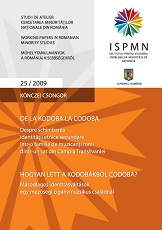De la Kodoba la Codoba. Despre schimbarea identităţii etnice secundare într-o familie de muzicanţi romi dintr-un sat din Câmpia Transilvaniei.
From Kodoba to Codoba. On changing the Secondary Ethnic Identity in a Family of Roma Musicians from a Village in the Transylvanian Plain
Author(s): Csongor Könczei
Subject(s): Cultural history, Music, Local History / Microhistory, Inter-Ethnic Relations, Ethnic Minorities Studies, Politics and Identity, Identity of Collectives
Published by: ISPMN Institutul pentru Studierea Problemelor Minorităţilor Naţionale
Keywords: Secondary Ethnic Identity; Roma Musicians; The Magyarpalatka; identity change; traditional dance music;
Summary/Abstract: The Magyarpalatka, located on Inner Mezőség, is one of the Gypsy musicians' centers in Mezőség. Many Gypsy music families lived and live here to date, the most famous being the Kodoba family. The present case study undertook to find out how the romungro family of the Reformed Religion in Romania, with the Hungarian-speaking, Reformed Religion, romanesque, in Hungarian, no longer (or hardly speaking) in the 20th Century, still a reformed, then Orthodox family, and tries to outline the broader social contexts of this process of identity change and to answer its causal relationships. Doing this by examining the extent to which the secondary identity change (including the change of the ethnic projection of the personal name) is related to the changing social, historical and political situations, to the extent that Magyarpalatka is continually depopulated from the Hungarian point of view, dominating the local Romanian population (not just numerical) and last but not least to some extent the economic aspects of the village vocational music industry. The research carried out at the same time makes it interesting that Gypsy musician of the Kodpal Gypsy family in Budapest is a Roma mother tongue, and its primary ethnic identity (for the time being) Roma, and that for the sake of its vocation has preserved the mediating role of local Hungarian, Romanian and Roma cultures as the traditional dance music of each ethnic group mediated and provided.
Series: STUDII DE ATELIER. CERCETAREA MINORITĂŢILOR NAŢIONALE DIN ROMÂNIA
- Page Count: 45
- Publication Year: 2009
- Language: Romanian, Hungarian
- Content File-PDF

